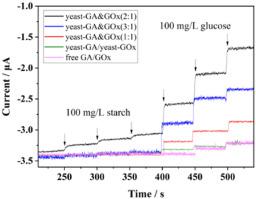Analytica Chimica Acta ( IF 5.7 ) Pub Date : 2022-07-16 , DOI: 10.1016/j.aca.2022.340173 Junchong Liu 1 , Qiaolin Lang 2 , Bo Liang 2 , Zongmei Zheng 1 , Yaru Zhang 1 , Aihua Liu 1

|
The sequential enzyme biosensors hold significant importance in measuring species which are usually hard to process with single-enzyme-based biosensors. However, sequential enzyme electrodes experience critical issues such as low catalytic efficiency, insensitivity and poor reproducibility. In this work, yeast surface co-displaying sequential enzymes of glucoamylase (GA) and glucose oxidase (GOx) with controllable ratios through the specific cohesion-dockerin protein interaction was explored, by which starch hydrolyzing by GA into glucose is the rate-limiting step. The modified electrodes were prepared by immobilizing yeast-GA&GOx whole-cell and reduced graphene oxide (RGO) on glassy carbon electrode (GCE), for which the direct electron transfer between the electrode and recombinant GOx was arrived. Interestingly, the current responses of sensors to starch and glucose are dependent on the displayed enzyme composition, of which the yeast-GA&GOx (2:1) exhibited the highest current. Thereafter, sequential enzyme sensor of yeast-GA&GOx (2:1)/RGO/GCE was developed. Based on reduction detection at negative potential without interference, the sensor is stable and capable of assaying glucose (linear range: 2.0–100 mg/L) or starch (linear range, 50–3500 mg/L), separately. Coupled with yeast-GOx/RGO/GCE glucose sensor, both glucose and starch in real samples can be detected satisfactorily. This work provides new ideas for the development of other sequential enzyme electrodes for potential applications.
中文翻译:

基于葡萄糖淀粉酶和葡萄糖氧化酶可控共展示酵母重组体的葡萄糖和淀粉敏感电化学序列酶生物传感器
顺序酶生物传感器在测量通常难以用基于单酶的生物传感器处理的物种方面具有重要意义。然而,连续酶电极存在催化效率低、不敏感和重现性差等关键问题。在这项工作中,我们探索了酵母表面通过特定的cohesion-dockerin蛋白相互作用以可控比例共展示葡萄糖淀粉酶(GA)和葡萄糖氧化酶(GOx)的顺序酶,其中GA将淀粉水解成葡萄糖是限速步骤. 通过将酵母-GA&GOx全细胞和还原氧化石墨烯(RGO)固定在玻碳电极(GCE)上制备修饰电极,从而实现电极与重组GOx之间的直接电子转移。有趣的是,传感器对淀粉和葡萄糖的当前响应取决于显示的酶组成,其中酵母-GA&GOx (2:1) 表现出最高的电流。此后,开发了酵母-GA&GOx (2:1)/RGO/GCE序列酶传感器。基于无干扰的负电位还原检测,传感器稳定,能够分别测定葡萄糖(线性范围:2.0-100 mg/L)或淀粉(线性范围,50-3500 mg/L)。配合酵母-GOx/RGO/GCE葡萄糖传感器,可以对真实样品中的葡萄糖和淀粉进行满意的检测。这项工作为开发其他潜在应用的顺序酶电极提供了新思路。开发了酵母-GA&GOx (2:1)/RGO/GCE序列酶传感器。基于无干扰的负电位还原检测,传感器稳定,能够分别测定葡萄糖(线性范围:2.0-100 mg/L)或淀粉(线性范围,50-3500 mg/L)。配合酵母-GOx/RGO/GCE葡萄糖传感器,可以对真实样品中的葡萄糖和淀粉进行满意的检测。这项工作为开发其他潜在应用的顺序酶电极提供了新思路。开发了酵母-GA&GOx (2:1)/RGO/GCE序列酶传感器。基于无干扰的负电位还原检测,传感器稳定,能够分别测定葡萄糖(线性范围:2.0-100 mg/L)或淀粉(线性范围,50-3500 mg/L)。配合酵母-GOx/RGO/GCE葡萄糖传感器,可以对真实样品中的葡萄糖和淀粉进行满意的检测。这项工作为开发其他潜在应用的顺序酶电极提供了新思路。实际样品中的葡萄糖和淀粉都可以得到满意的检测。这项工作为开发其他潜在应用的顺序酶电极提供了新思路。实际样品中的葡萄糖和淀粉都可以得到满意的检测。这项工作为开发其他潜在应用的顺序酶电极提供了新思路。









































 京公网安备 11010802027423号
京公网安备 11010802027423号